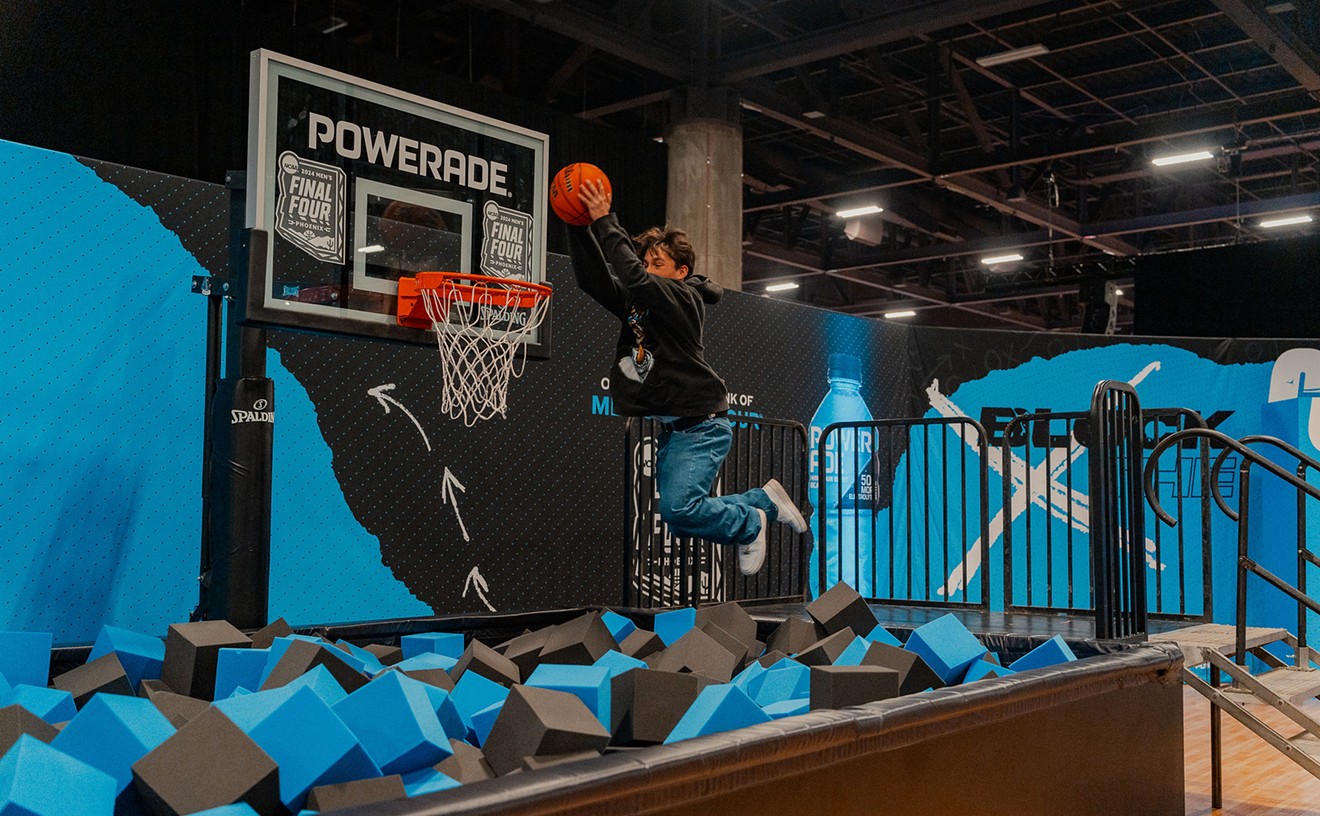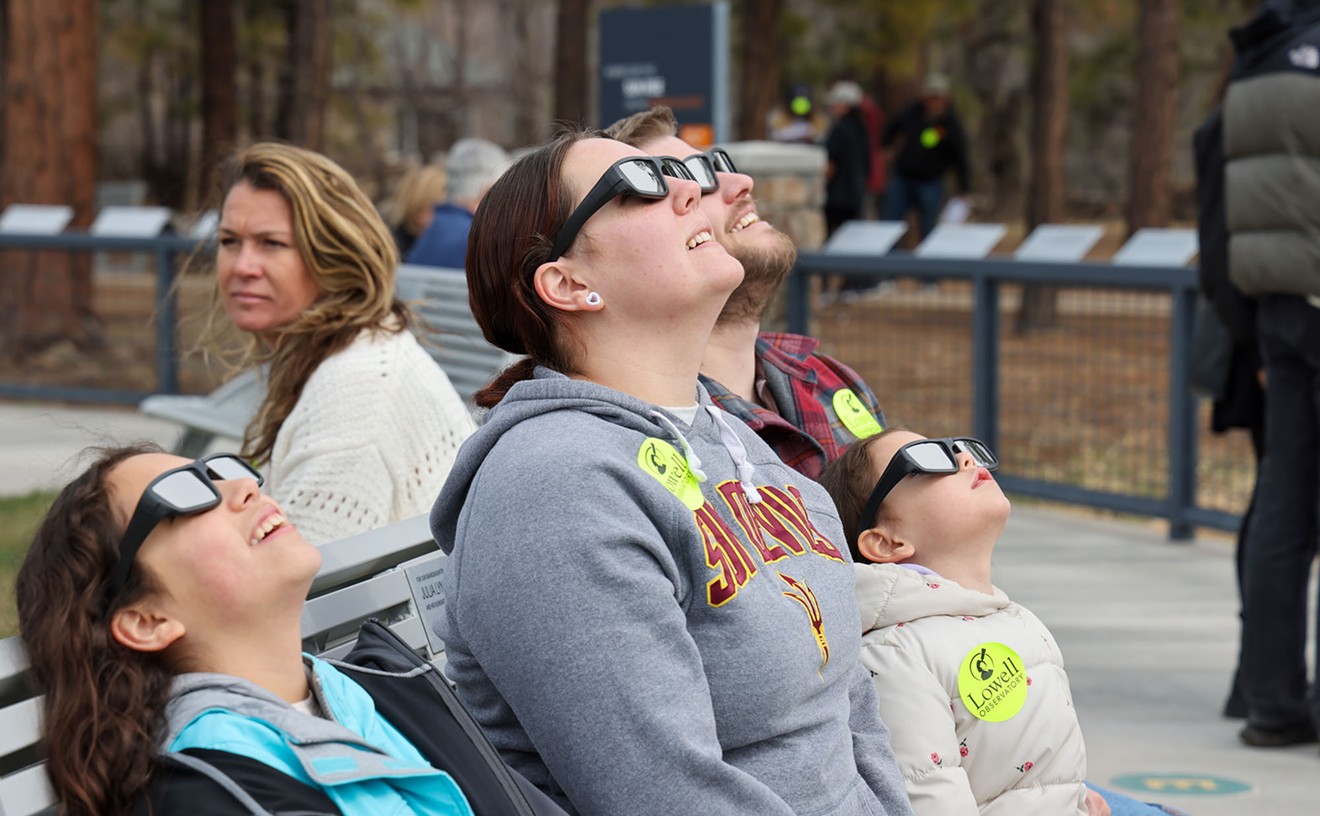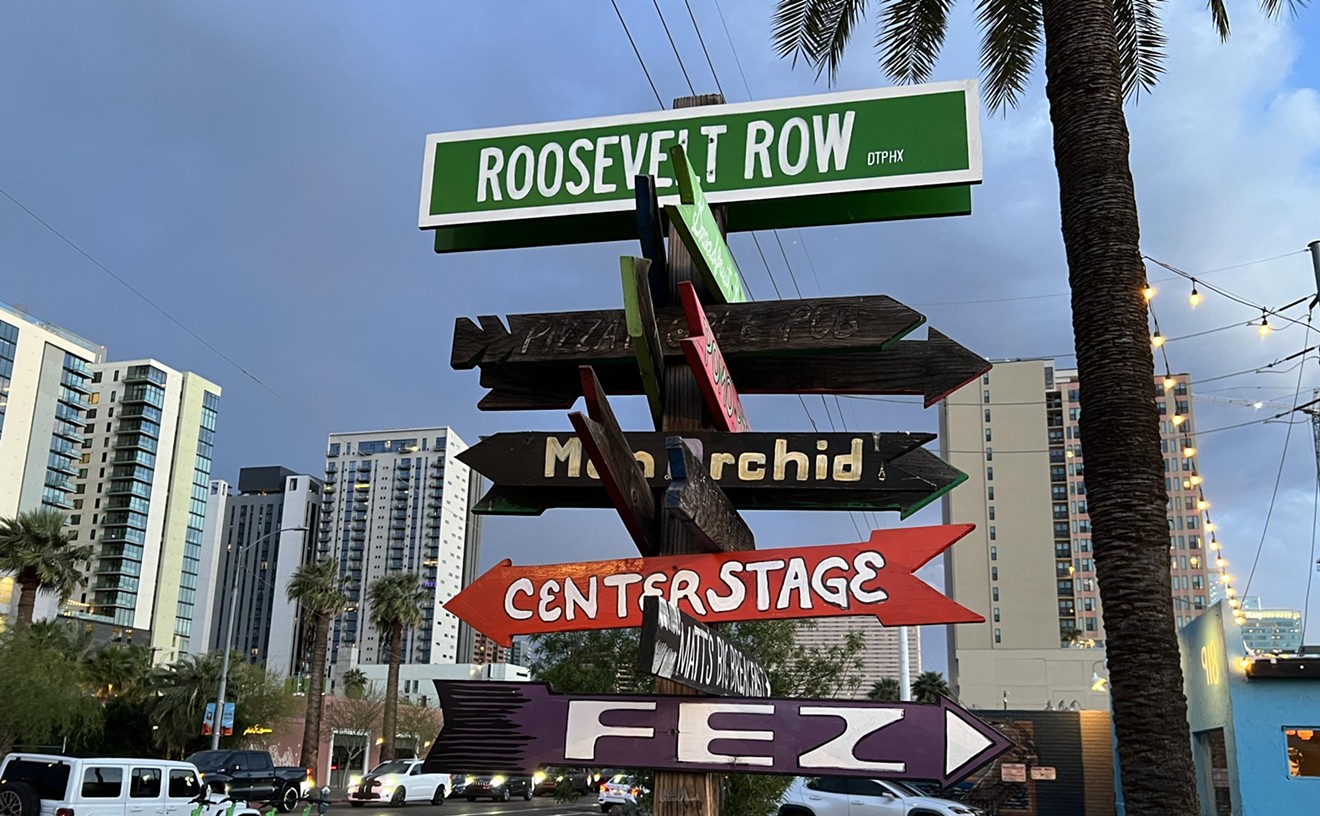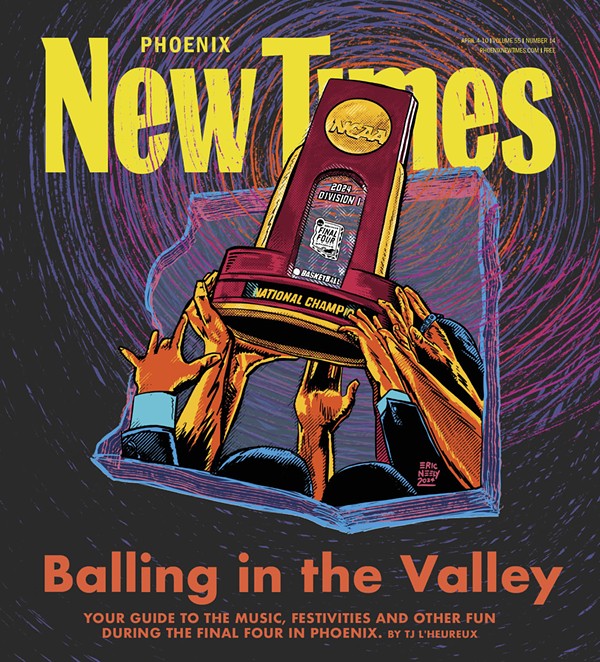And they worked. Modified Arts has been a staple of the creative scene in downtown Phoenix for two decades — nurturing the talents of some of the city’s best-loved artists and musicians.
It’s a significant achievement, especially when you consider the venue’s humble beginnings — and its ongoing presence amid myriad changes wrought by rampant development in Roosevelt Row.
When Modified Arts opened at 407 East Roosevelt Street, it was surrounded by empty lots and boarded-up buildings. “The neighborhood was full, but the commercial spaces were empty,” Lanning says. “Twenty years ago, the street was largely vacant.”
Now, it’s part of a bustling arts district. And Lanning, who founded Local First Arizona in 2003, is a key player in city life.
Lanning celebrated the 20-year milestone during November’s Third Friday, surrounded by creatives and other community members gathered at Modified Arts. It was the opening reception for an exhibit called “A City, Modified,” which continues through December 14.
Some marveled at her DIY invitations, and a collage of postcards from more recent art shows. Others lingered over a trio of aerial maps showing changes to the Evans Churchill neighborhood that’s home to Roosevelt Row.
They’re labeled with the years 1930, 1999, and 2018.
Like the city that surrounds it, Modified Arts has evolved.
When Lanning bought the red brick building from Tom Carmody, the area was best known for crime and urban blight.
At the time, Lanning’s focus was Stinkweeds, the record shop she started in 1987 and still heads today. Lanning noticed that promoters weren’t booking bands in Phoenix, and resolved to put the local music scene on the map. “I will not be in the same category as Albuquerque,” she recalls thinking at the time.
Lanning hopped on the phone, calling promoters and working to build trust.
Soon, touring bands and locals were playing at Modified Arts. Arcade Fire, Cold War Kids, and Vampire Weekend performed there before making it big on the wider music scene. And several local musicians who performed there went on to play with well-known bands.

KImber Lanning on the Modified Arts stage in the early days when it was a music venue.
Kimber Lanning
“I wanted to stop the revolving door of talented young people moving to other cities, and make it easier for them to start music careers in Phoenix,” she says.
But Lanning had another goal. “I knew theater students and poets and painters, and none of them would go out and support each other’s stuff,” Lanning recalls. “I’ll never forget seeing death metal kids watching visual artists install their work.”
Despite the successes, Lanning shifted the venue’s focus away from music in late 2009. She was already doing exhibits, and decided it was time to simplify. So Lanning turned Modified Arts into a gallery.
By then, a handful of additional galleries had taken shape on Roosevelt Street. Wayne Rainey had opened monOrchid at 214 East Roosevelt. And the Eye Lounge artist collective had opened its gallery at 419 East Roosevelt, in a building owned by Greg Esser and Cindy Dach.
As the arts scene flourished, the area drew more attention.
Roosevelt Row was lauded as one of the country’s best art districts. Developers flocked to the area, sometimes demolishing or displacing the very creative spaces that made the neighborhood so popular. “The development community didn’t recognize the sweat equity the artists had put in,” Lanning says.
Baron Properties built two midrise apartment buildings at the corner of Roosevelt and Third streets, demolishing a small building that was home to the GreenHaus gallery and boutique. Desert Viking bought the former Flowers building at Roosevelt and Fifth Street, which left three galleries looking for new locations. And True North Studio purchased several properties, including monOrchid.
Lanning marked the changes by commissioning Hugo Medina to create a mural for the east side of Modified Arts. Painted with primary colors, it shows a young artist with her head buried in her hands. “In a sense, it’s grieving the loss of the arts district,” she says.
Lanning says she’s sad about the number of artists and small businesses that got displaced. But she’s also mad. “I’m angry about the architects with mediocre ideas making millions off the energy we created,” she says.
But Lanning has been busy making some changes of her own.
She acquired a house that sat across the street from Modified Arts in 2015, then had it moved to save it from demolition. Today, the renovated Wurth House sits just west of Modified Arts, where it’s home to Local First Arizona.
In 2018, Lanning renovated Modified Arts, creating a separate area inside the building for Local First Arizona staff whose desks once sat in the center of the gallery. Having staff there during the week means the gallery can be open regularly, rather than opening only for First and Third Fridays.
That’s one reason the gallery works, she says.
But there are others.
During the past decade, she’s hired a series of gallery directors to curate the space. Connor Descheemaker spent five years in the role before relocating to Seattle. “Connor was rooted in urban planning and had a deep understanding of gentrification,” she says. “He shined a light on inequities in the community.”
Descheemaker was there in 2017 when an exhibit showing a white photographer wearing blackface went up in a nearby arts space. The exhibit drew strong criticism, and Modified Arts issued a successful call for the exhibit to close. Then, Modified Arts broadened the conversation with an exhibit of works by black artists.
Today Modified Arts is co-curated by two artists of color — gallery director Miguel A. Monzón and gallery assistant Merryn Alaka.
For “A City, Modified,” they chose several artists with long ties to the gallery, including Monica Aissa Martinez. Martinez had just moved to Phoenix 20 years ago when she first discovered Modified Arts. “It was First Friday, and it was raining cats and dogs,” she says. “There was a stage where the offices are now, and it was wall-to-wall people.”
Years later, she showed work at Modified Arts. And she’s part of the current show, as well. “We need spaces like Modified Arts, where you can put your work out there and get people to respond to it.”
As people entered the gallery during Third Friday, they spotted a pair of photographs on a red brick wall. One shows Modified Arts before Lanning bought it. The other shows the building as it looks today.
“Kimber is the reason Modified Arts is still here today,” says musician Brian Coughlin. “It takes a courageous visionary like Kimber to build an establishment like that.”
Coughlin praises Lanning for seeing what others don’t and breaking her vision down into steps and plans. He says, “I really question what downtown would look like if Modified Arts hadn’t broken the seal.”
Phoenix Creatives Share Their Memories of Modified Arts
Artists reflect on the gallery’s past, present, and futureChristine Cassano
Christine Cassano is an interdisciplinary artist whose work has been exhibited locally, nationally, and internationally, and is represented by Gebert Contemporary in Scottsdale. In 2016, she received an artist grant from the Phoenix Art Museum Contemporary Forum. Christine exhibited work at Modified Arts in 2014 and 2016. Her Glasshouse of Cards is featured in the 20th-anniversary exhibit at Modified Arts.
“I moved here in the summer of 2001. I remember going with a friend to a really intense punk show at Modified Arts. It was a tiny little space. It was really unexpected and very intimate. “I first showed there after Connor Descheemaker reached out to me. I had a new body of work about the biology and technology. I showed with Sean Thomas. The gallery had been on my radar, and I was just really honored to be asked to show my work there. I also did a show with Bill Timmerman in 2016. I remember Will Bruder coming to the show the first night and talking about how the work could be laid out so differently. So we rearranged the work for an artist talk. They’re so thoughtful with the way they curate their shows. And they bring in a full range of people. It’s helped my career in so many ways, by giving me visibility. The entire landscape has changed since 2001. Walking by and seeing that Modified Arts and Eye Lounge are still here always makes me smile.”
Sue Chenoweth
Sue Chenoweth has been a staple of the Phoenix arts scene for two decades. Her work has been featured in several solo and group exhibitions at Modified Arts. Chenoweth works primarily in drawing and painting, using mediums that include acrylic paint, gouache, ink, and pencil. In 2010, Chenoweth had a solo exhibition at Scottsdale Museum of Contemporary Art.
“I showed work several times at Modified Arts, including a show in 2012 called ‘Real and Applied.’ Ted Decker did that show, which included several of my paintings from a residency in Rio de Janeiro. Modified Arts is a very important place, and they have some really, really good shows. I remember the old layout with the bathroom in the middle. Modified Arts was one of the first galleries on the south side of Roosevelt Street. The crowds were pretty good. The gallery was intimate, and people would come inside to see the art before it got too crazy down there. I sold a lot of pieces. It used to be kind of grungy, not polished like it is now. Kimber has always been amazing. I only went to a couple of music shows there. I remember going to the Brent Green show. That was amazing. Now, he’s a New York star. I was glad when it became an art gallery. Modified Arts was a stepping-stone place for a lot of artists.”
Stephen Chilton
Stephen Chilton is a Phoenix native who has been promoting concerts since 2000, the year he launched his company, Psyko Steve Presents. Chilton is also the owner and talent buyer at The Rebel Lounge. He’s also served as a marketing director for Crescent Ballroom and Stateside Presents.
“Early on, I saw The Anniversary at Modified Arts. There were about 50 people there. There was nothing else on Roosevelt. It had a really different vibe than it has now. Part of the reason shows worked there is they were really far from the mainstream artists that got booked other places. A lot of avant-garde artists played there. There was a lot of really obscure stuff. I made the flyer when Arcade Fire played there. Some of the other bands that played there were St. Vincent and The Decemberists. That was where anybody could play. That’s where I learned to do shows. A lot of the local arts scene grew out of that space. I reached out to Jimmy Eat World and heard that Jimmy would do a few songs with Ruebens Accomplice. Instead, Jimmy Eat World did about 10 songs. His appearance was supposed to be a secret, even from Kimber. But somebody put it out online, so about 2,000 people showed up hoping to hear Jimmy Eat World for $5. Only about 150 got in. When they were done, they loaded up their stuff just like any other band. That was fun.”
Brian Coughlin
Brian Coughlin is a Phoenix musician best-known for playing with indie-pop band Kinch, who have opened for Calexico, The Thermals, Against Me!, Ra Ra Riot, Taking Back Sunday, and Mini Kiss. Kinch released their album, The Incandenza, in 2011.
“The very first time I saw a show there was back in the late ’90s. I had no expectations. I had never been downtown, except for maybe a sporting event. Modified Arts felt like this tiny house surrounded by dirt lots. It felt like a Mad Max wasteland, complete with bonfires. It was the first time I heard music outside of MTV or corporate arena culture. After that, I knew I wanted to be in a band. It was the first place I got to meet and talk to bands in person, as humans. I showed up at Stinkweeds one day and asked Kimber how to get booked, and I remember Kimber saying, ‘Why don’t you just promote yourself?’ She took the time to explain what it really takes to put on a show, and we ended up booking ourselves at Modified Arts. I went to the opening for the 20th-anniversary show, and I kept feeling like I had time-traveled. It was definitely bittersweet when Kimber decided to turn the space into an art gallery. The space had a vibe that’s so often lacking. It still reminds me that you can have an idea and build something that lasts. It was a blank canvas. It’s actually a downtown now.”
Greg Esser
Artist Greg Esser is the founder of the Roosevelt Row Community Development Corporation. Previously, he directed Phoenix’s public art program. Esser owns property in Roosevelt Row, where he’s helped to launch art spaces that include Eye Lounge, MADE, and Five15 Arts.
“We purchased Eye Lounge after Kimber bought Modified Arts. Wayne Rainey opened monOrchid, and we had a kind of synergy. People were afraid to walk down the streets when Modified Arts opened. Everything was boarded up, and the street was dark. Downtown was still in decline, but a handful of property owners like Angie Pappas were receptive to artists coming in. Kimber has always been an inspiration for me. She’s a beacon in downtown Phoenix, who’s always had a clear vision. Modified Arts showed work by people that might not get a show in other places. Kimber could have easily torn the building down, like the person next to her. She honors historical preservation, despite the market forces. Reaching 20 years is quite an accomplishment. I just told her during Third Friday, ‘We’re only at the beginning of the journey.’”
Sam Means
Sam Means is a songwriter, vocalist, keyboardist, and half of the Arizona indie-pop band The Format from 2001 until 2008 with Nate Ruess, who later formed the band fun. Means released his debut full-length album, 10 Songs, in 2016 and founded Hello Merch, a company that specializes in band merchandise.
“The cool thing is, I used to love downtown Phoenix. My dad worked there, but I never had a reason to go down there. The first place I experienced shows downtown was Modified Arts. Kimber brought in all the cool bands. The Format played at Modified Arts a lot, even when we had outgrown the space. It’s possible that one of our first shows was at Modified Arts. When a friend drove us down Roosevelt Street, we were pretty shocked. It was pretty bleak. Across the street, there was a big dirt lot. Now, there’s a huge apartment building. There wasn’t really anything else around, and it was a little bit sketchy. But I had no fear of being there. Kimber still influences me, now that I’m a business owner. Coming from the indie band DIY scene gave us a certain set of ethics. As you grow, a lot of people forget where they started; they get too big for their britches. But Kimber and Modified are still genuine. It’s a bummer that it’s not a music venue anymore, but maybe someday shows will happen there again. I’ve toured all around for years. Modified was so simple and basic, but it’s really unique.”
Some quotes have been condensed and edited for brevity and clarity.























